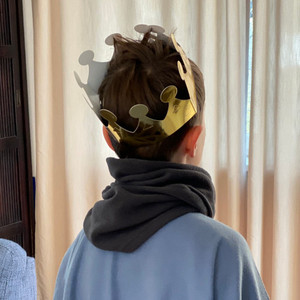Does your child have mucus in their throat? Speech therapist Andrea Gumberger-Strobl gives tips on how children can gently and naturally rid themselves of mucus in their throat.

Having mucus in your throat is normally harmless. However, you should take your child to see a doctor if your child regularly complains of mucus in their throat. “You should always first approach a paediatrician, ENT physician or specialist for phoniatrics and pedaudiology, i.e. an expert in the vocal cords. They can find out why there is a build-up of mucus in the throat. Generally they will examine the child to make sure everything is fine from an organic point of view and the doctor can rule out certain diseases such as asthma or cystic fibrosis. Both diseases can contribute to the child’s throat regularly being filled with mucus”, explains the speech therapist Andrea Gumberger-Strobl.
She has been working for almost 20 years in her own speech therapy practice in the Erding region in Germany. She treats a lot of children, but also adults, with voice, speech, language and swallowing disorders. Her patients include many who struggle with a build-up of mucus in their throat.
Watch your child carefully and keep a throat diary if needs be where you can record if your child always gets or complains about mucus in their throat at a certain time of day or in connection with a certain food. “If you notice that your child’s throat fills with mucus as a response to a certain type of food, your child should try avoiding this food. If the mucus stops when they avoid the food, you have found the culprit. Some foods, such as milk, especially contribute to a build-up of mucus in the throat. If your child is fond of spicy food, you should bear in mind that this irritates the mucosal membranes in the vocal apparatus and so can lead to more mucus”, Gumberger-Strobl explains.
Hum with your child in the morning and throughout the day. The vibrations that develop as you hum loosen the mucus on the vocal folds. And a beneficial side effect is that humming puts you in a good mood. This exercise is especially sensible if your child wakes up in the morning with mucus in their throat. “Humming is a gentle type of voice hygiene while clearing your throat puts strain on the vocal folds. So casually hum any sequence of notes you like with your child. Vary the notes. This exercise is like a little massage for your voice apparatus. Your child should then cough up the loosened mucus.”
You can also turn the humming into a game. Hum a tune and get your child to copy it and then vice versa. Or give orders like: Hum like a bee flying over a meadow. Or: Hum like a hippopotamus. Or: Hum like an elf. There are no limits to your imagination. The main thing is that your child hums.

Another exercise to loosen mucus in the throat is to say words beginning with an M, and then to follow this with a long vowel like O and OO, such as “mow” or “mood”. You have to say the words in a special way though. The speech therapist explains it like this: “Your child may say the word “mow”, for example. But he or she should linger on the letter M, so they end up saying “mmmmmmmmmmmmmmmmmow” Say it yourself and then get your child to copy you. It is important that you say the words in a monotone voice with a deep and calm pitch. Lingering on the letter M activates the muscles of the vocal folds where the irritating mucus has become lodged.”
It is more fun if you and your child make up words together starting with “mo” or “moo”. Another variant would be making up sentences or a whole story made up entirely of words starting with the letter “m” followed by a long vowel. Children enjoy it most if they make up nonsense sentences.

Get out that scarf, shawl or buff! “The neck and throat region and the shoulders form a single unit. And so it is important not only to keep your throat warm in winter and in cold weather, but also the shoulder area. You should make sure your child is not exposed to draughts”, the speech therapist recommends. Your child may prefer to wear a scarf if you sell it to them as a shawl worn by an elegant lady or a shawl worn over the shoulders as a cloak worn by a superhero, a king or queen or a vampire. Try it out.
Your child will especially appreciate this tip. “To take care of your voice, it is always helpful to suck sweets or lozenges. But is important that they do not contain menthol, as this irritates the vocal folds. It is also sensible to give children sugar-free sweets or throat lozenges”, she explains.
Drinking regularly tends to be a challenge for children. But if they have mucus in their throat, it is really important as it helps keep their throat and voice healthy. The speech therapist has the following advice: “Motivate your child to drink by making a game of it. Drink something too and clink glasses with your child or toast each other with a drink. Drink through a straw, but cross over glasses to drink – your straw in a glass in that closer to your child and your child’s straw in a glass that is closer to you. While you drink, you have to keep your heads together – this can be funny and therefore motivating. Ideally give your child lukewarm, still and clear water. Avoid fizzy drinks. They irritate the voice. Herbal teas such as sage tea are also suitable. But avoid camomile. It has a drying effect. Not a lot of people know that.”


“Inhaling with saline (NaCl) with a nebuliser moistens the throat which means the secretions can be more easily and gently liquified. This is especially recommended if the mucus is thick or persistent and very unpleasant for your child. There are also special medications for inhalation that some children are prescribed by the doctor”, she explains.
» click here for tips for adults to manage mucus in their throat
Andrea Gumberger-Strobl has been working for almost 20 years in her own speech therapy practice in the Erding region in Germany. Before that she worked for many years in the Landshut and Freising regions in early language development. In her speech therapy practice she treats children and adults with voice, speech, language and swallowing disorders.
Note: The information in this blog post is not a treatment recommendation. The needs of patients vary greatly from person to person. The treatment approaches presented should be viewed only as examples. PARI recommends that patients always consult with their physician or physiotherapist first.
An article written by the PARI BLOG editorial team.
© 2026 PARI GmbH Spezialisten für effektive Inhalation